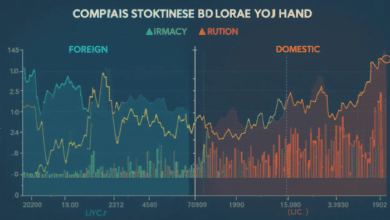FII DII Data: Market Trends and Investment Strategies

Today FII DII Data refers to the inflow and outflow of funds in the stock market by Foreign Institutional Investors (FII) and Domestic Institutional Investors (DII). This data is crucial for understanding market trends, investment behavior, and market sentiment. It plays a significant role in determining stock prices, influencing both short-term and long-term investment decisions. Today FII DII Data acts as a barometer for market confidence and volatility, helping traders and investors gauge how foreign and domestic entities are reacting to current economic conditions.
Today FII DII Data is published daily by various financial institutions and market regulators. By analyzing this data, one can observe the level of interest and confidence that both foreign and domestic investors have in a particular market. When FIIs are buying heavily, it generally reflects confidence in market growth, while DII buying may show domestic support, especially during market corrections.
FII and DII: Key Players in Today’s Stock Market
Foreign Institutional Investors (FII) are entities based outside a country that invest in its financial markets. FIIs include hedge funds, pension funds, and other financial institutions looking to capitalize on market opportunities outside their own countries. On the other hand, Domestic Institutional Investors (DII) are organizations within a country, such as mutual funds, insurance companies, and banks, that invest in the domestic market.
Today FII DII Data reveals the level of influence these institutions have on market fluctuations. FIIs often bring in large volumes of capital, which can significantly impact the market, especially in emerging economies. DIIs act as a stabilizing force, counteracting foreign capital flows. Their investments tend to align with long-term market outlooks and economic fundamentals, making Today FII DII Data a crucial resource for understanding market stability.
How Today FII DII Data Impacts Market Sentiment and Trends
Today FII DII Data is an essential indicator of market sentiment. When FIIs increase their buying activity, it generally signals positive sentiment toward the economy. Conversely, when FIIs sell, it can lead to market corrections or increased volatility, especially in emerging markets where foreign capital plays a larger role. DIIs, however, often invest based on domestic economic fundamentals and act as a balancing force when FII activity disrupts the market.
The data from Today FII DII Data also helps investors identify trends in specific sectors. For instance, if both FIIs and DIIs are heavily investing in technology, it may indicate strong growth potential in that sector. On the other hand, if they are withdrawing, it could mean sector-specific challenges or an anticipated slowdown.
How to Access and Interpret Today FII DII Data
Today FII DII Data is readily available through various financial news platforms, stock exchange websites, and market analysis tools. To interpret the data, investors should consider both the volume and direction of investments. Consistent FII inflows indicate positive sentiment and an anticipated rise in market indices, while high DII activity in specific sectors can highlight emerging opportunities.
Investors can access this data to align their strategies with institutional trends. For example, if Today FII DII Data shows a surge in foreign investment in the energy sector, investors may consider this as a positive indicator. Analyzing these trends allows retail investors to make informed decisions based on institutional confidence and market momentum.
Factors Influencing Today FII DII Data: Economic Indicators and Global Trends
Several factors influence Today FII DII Data, including global economic conditions, domestic policies, and geopolitical events. Interest rates, inflation rates, and currency stability are major drivers for FII flows, as foreign investors seek profitable and stable environments for their capital. For instance, an interest rate hike in the U.S. may reduce FII inflow to emerging markets as investors find safer yields in their home country.
Domestic factors such as government policies, corporate earnings, and economic reforms significantly impact DII behavior. For example, tax incentives for certain sectors may attract DII investments in those industries. Today FII DII Data often reflects the combined effects of these domestic and global influences, making it a comprehensive indicator of the market’s current dynamics.
How Retail Investors Can Benefit from Analyzing Today FII DII Data
For retail investors, Today FII DII Data offers a wealth of information that can help in creating strategic investment decisions. By understanding the movements of large institutional investors, retail investors can identify patterns and align their portfolios accordingly. For instance, consistent FII buying in the technology sector may signal growth potential, encouraging retail investors to increase their exposure in tech stocks.
Retail investors can use Today FII DII Data to understand which sectors are likely to be influenced by institutional buying or selling. This information is beneficial for both short-term traders and long-term investors. By monitoring daily FII and DII trends, retail investors gain insights that are typically not as easily accessible through other metrics.
Common Misconceptions About Today FII DII Data
A common misconception about Today FII DII Data is that it is only relevant for large-scale investors or day traders. However, understanding institutional investment flows is crucial for all types of investors. Another misconception is that high FII inflows always lead to positive returns. In reality, while FII inflows can boost market confidence, they may also lead to volatility, especially if there’s a sudden withdrawal.
Additionally, many assume that Today FII DII Data alone can predict future market trends. While it’s a valuable indicator, it should be used alongside other economic data, such as GDP growth and corporate earnings. The data is one of several factors influencing market trends, and a holistic view is essential for accurate market predictions.
Today FII DII Data and Its Role in Sectoral Investment Decisions
Today FII DII Data can significantly influence sectoral investments. Institutional investors often focus on specific sectors based on anticipated growth, government policy, or global demand trends. For example, if FIIs are investing heavily in green energy, it could suggest future growth and profitability within this sector. DIIs may follow suit if domestic conditions also favor that sector, stabilizing growth prospects.
Analyzing Today FII DII Data at the sectoral level allows investors to spot emerging trends and growth sectors. It provides a clear indication of where institutional confidence lies, enabling investors to target their investments in promising industries. Such sectoral insights from Today FII DII Data help investors make more informed, growth-oriented investment decisions.
Strategies for Investors Based on Today FII DII Data
Investors can develop effective strategies by examining Today FII DII Data trends. For instance, investors might adopt a bullish strategy if there’s a consistent FII inflow across multiple days, signaling strong market confidence. On the other hand, if DIIs are buying amid a selling trend by FIIs, it might be a signal of strong domestic fundamentals, prompting a defensive or contrarian strategy.
Different strategies based on Today FII DII Data include sectoral rotation, momentum trading, and contrarian investing. By understanding the data’s implications, investors can optimize their portfolios to capture gains from institutional buying trends. Monitoring the data allows them to pivot their strategies based on changing market conditions, enhancing portfolio performance.
How Economic Events Shape Today FII DII Data Trends
Economic events, including policy changes, global crises, and corporate earnings reports, have a profound impact on Today FII DII Data. For instance, a major tax reform may attract both FII and DII investments, signaling increased market growth potential. Conversely, global crises like trade wars or pandemics may reduce FII inflows as foreign investors seek safer environments.
Today FII DII Data is particularly sensitive to economic developments that impact investor confidence. By understanding how economic events shape these trends, investors can anticipate institutional responses and make strategic adjustments to their portfolios. This understanding allows investors to align their portfolios with broader economic trends, making Today FII DII Data an invaluable tool.
Conclusion
Today FII DII Data is a valuable resource for investors looking to understand market dynamics and institutional investment trends. By monitoring this data, investors gain insights into the behavior of foreign and domestic institutions, helping them make informed decisions. The data offers valuable indicators of market sentiment, sectoral growth potential, and responses to economic events.
Using Today FII DII Data, investors can optimize their portfolios to align with institutional confidence and market conditions. By adopting strategies that align with FII and DII trends, they stand to benefit from improved returns. In a volatile market, understanding and utilizing Today FII DII Data is essential for making strategic investment choices that maximize growth potential.
FAQs
Q1: Where can I access Today FII DII Data?
A: Today FII DII Data is available on financial news websites, stock exchange platforms, and market analysis tools. Many brokerage apps also provide daily updates.
Q2: How does Today FII DII Data impact stock prices?
A: Today FII DII Data impacts stock prices as large inflows or outflows by institutions can lead to price fluctuations based on investor sentiment.
Q3: Can Today FII DII Data predict market trends?
A: While Today FII DII Data is a strong indicator of market sentiment, it should be used alongside other economic factors for accurate predictions.




